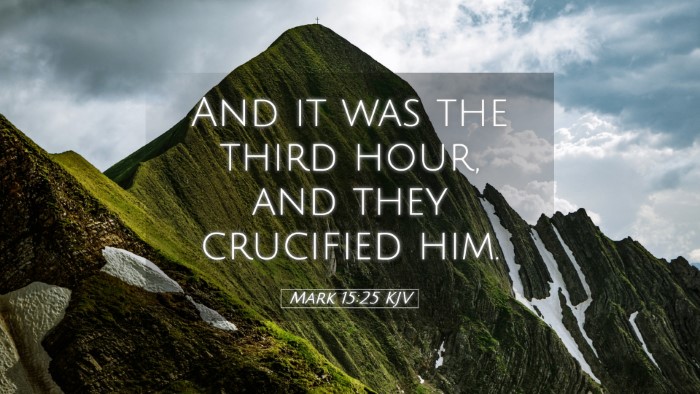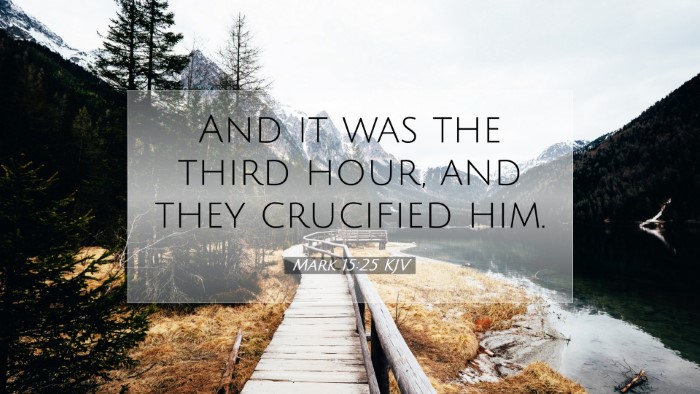Commentary on Mark 15:25
Verse Reference: Mark 15:25 - "And it was the third hour, and they crucified him."
Introduction
This verse marks a pivotal moment in the Gospel narrative, encapsulating the anguish and gravity of the crucifixion of Jesus Christ. As we delve into the insights provided by several public domain commentaries, we aim to illuminate the significance of this moment for pastors, students, theologians, and scholars alike.
Contextual Analysis
The phrase "the third hour" aligns the crucifixion with Jewish timekeeping, which begins at sunrise. This setting is critical in understanding the timeline of Jesus' suffering. The crucifixion occurred around 9 AM, the moment when judgment was being executed by the authorities, aligning with the prophesied suffering of the Messiah.
Insights from Matthew Henry
Henry's commentary highlights the fulfillment of prophecy and the profound significance of the timing of Christ's crucifixion. He emphasizes that the specified hour underlines God’s sovereignty over the events leading to the crucifixion. Henry notes that this moment reflects both the malice of man and the mystery of divine purposes, underscoring how humanity's rejection of Christ is met with His unwavering submission to God's will.
- Divine Timing: The mention of "the third hour" signifies God's perfect timing in redemptive history.
- Fulfilled Prophecy: Henry points out that Jesus’ suffering was preordained as a fulfillment of Old Testament predictions.
Insights from Albert Barnes
Barnes elucidates the implications of "they crucified him." He notes that the term signifies not merely the physical act but the culmination of years of rejection by the religious leaders of Israel. Barnes argues that the crucifixion reflects the ultimate expression of sinful humanity in its rebellion against God. The act of crucifying Christ serves both as a form of judicial execution and as a profound spiritual statement about humanity's condition.
- The Nature of the Crime: It shows the extreme depravity of a society rejecting its Savior.
- Call for Reflection: Barnes challenges the reader to consider their own stance toward Christ in light of this historical act.
Insights from Adam Clarke
Clarke’s commentary delves into the historical and cultural context of crucifixion, explaining that it was the most shameful and torturous form of execution, reserved for the vilest criminals. He emphasizes that Jesus accepted this disgrace not just as a form of punishment, but as a sacrificial act for the redemption of mankind. Clarke encourages readers to recognize the profound love displayed in this act of willingly suffering for sin.
- Cultural Significance: The form of execution highlights the depth of human shame and sin.
- Theological Implications: Clarke connects this moment to the redemptive plan, indicating that Christ’s death was essential for the salvation of humankind.
Theological Considerations
Theological reflection on Mark 15:25 leads to a deeper understanding of atonement, grace, and the nature of sin. The act of crucifixion serves not only as a historical event but as a theological cornerstone that informs doctrines of redemption and reconciliation with God.
- Atonement: The crucifixion embodies the sacrificial system, where Christ becomes the Lamb of God.
- Grace: This moment signifies the ultimate act of grace, showcasing unmerited favor towards humanity.
- Reconciliation: The death of Christ paves the way for reconciliation between God and humanity, fulfilling the promise of redemption.
Conclusion
Mark 15:25 serves as a crucial moment in the narrative of Christ's passion, presenting rich ground for reflection and theological exploration. As gleaned from the insights of Matthew Henry, Albert Barnes, and Adam Clarke, this verse invites us to contemplate the profound implications of the crucifixion. It challenges us to embrace the significance of Christ’s suffering and to recognize our own response to this pivotal event, urging a commitment to the extraordinary grace offered through His sacrifice.


